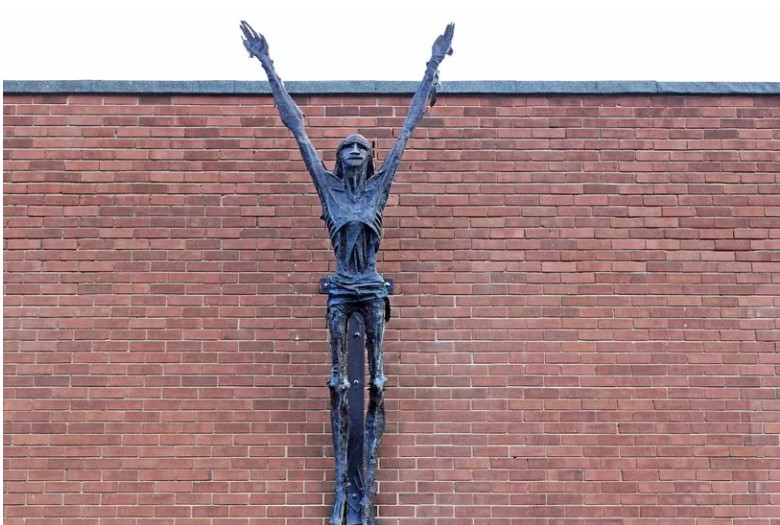
Arthur John Dooley (17 January 1929 – 7 January 1994) went from being a welder at Cammell Laird shipbuilders on leaving school, to developing as an artist making impassioned religious sculptures in metal, via the Irish Guards, the Palestine Liberation Organisation, and a cleaning job at St. Martin’s School of Art, where he finally found his true vocation.
The Black Christ
As a kid I regularly came face to face with the Black Christ, as my bus stopped just yards from the outstretched arms of this Liverpool landmark. From the top deck I could see the intricate metalwork of exposed muscle and sinew as the shocking figure reached out towards me.
The Black Christ resurrected
Arthur Dooley’s now Resurrected Christ is fixed to the wall of the Methodist Church on Princes Avenue, Liverpool 8. For many Liverpudlians it is the most prominent of the works left by this worker artist.
Popularly known as the Black Christ, it was received with outrage and horror by some at the time of its installation in 1969. Not for Arthur the Western depiction of Christ as a white, bearded and haloed hippie. Arthur not only saw, but celebrated, the pain and struggle through adversity that the resurrection represents.
As the Reverend Donald May noted in his sermon at the time: ”The Resurrection has a message of hope for our modern world as a whole. The forces of evil and destruction seem to be so powerful; there is so much that threatens to crush the human spirit. The Resurrection…gives the assurance that as He triumphed over the powers of hatred, evil and death, so in the end God and goodness, justice and freedom, love and peace, will be victorious.”
Work and life of the young Dooley
As a welder at Cammell Laird shipyard when he left school, Arthur understood and worked with metal, but more than that, he understood those he lived and worked among, and that justice and freedom would only come through struggle. As a lifelong socialist, former member of the Communist Party, and devout Catholic, his religious work expresses the pain and struggle of the working class.
No doubt in search of adventure, Arthur enlisted in the Irish Guards in 1946. Whether the adventure he found was to his liking was another matter, as he went absent without leave before briefly joining the Palestine Liberation Organisation. Back in London, Arthur became a cleaner and later a student at St Martin’s School of Art.
Beginning to establish himself as an artist and sculptor, Arthur returned to his roots and set up a small studio in Liverpool in 1956. To support himself he worked in the Dunlop rubber factory, round the corner from my childhood home in Speke.

Risen: celebrating Arthur Dooley Day
Arthur Dooley’s art
Arthur launched his first London exhibition in 1962, and achieved widespread recognition for Fifteen Stations of the Cross in St Mary’s RC Church, Leyland. Despite his growing reputation within the art world, Arthur never lost his commitment to workers’ rights, and designed a bright red ‘Speaker’s Podium’ for the Liverpool Trades Council. The structure became a celebration of free speech and a space for discussion and protest. It was quietly dismantled in 1990 in a Council refurbishment of the Pier Head, and has since been lost.
In past years Dooley Day has been celebrated with public screenings, exhibitions and multimedia events, supported by The Florence Institute in the Dingle where Arthur was born, and by Writing on the Wall.
This year the celebration’s founder, local artist Tom Calderbank, will be conducting a tour of the sculptor’s studio, and has issued a call to all arts and cultural organisations in Liverpool, to make next year’s 10th anniversary the biggest yet.
The Resurrected Christ mentioned in literature
Arthur’s resurrected Christ appears in my third novel ‘Before The Storm’.
“Vinny pointed up. ‘I used to see that statue on the way home from town. It’s weird how something can be both so frightening and so beautiful. He’s the Black Christ?’
‘He’s supposed to be the resurrected Christ, but you know the guy who made it?’ asked Jaime.
‘No, no idea.’ said Vinny.
‘Arthur Dooley. Whenever I see the statue, I don’t see resurrection, but death. To me, he looks more like a famine victim from Ireland than a resurrected Christ.’
‘Wow, maybe you’re right.’ Vinny looked at the statue, arms outstretched. Black or Irish, who was the figure appealing to?”
A symbol of our struggle
It was Arthur Dooley’s hope that we could see ourselves in that tortured figure. As someone who walked the same streets, drank in some of the same pubs, and shares a similar Irish catholic socialist background, I see our continued struggle for justice and humanity.

Leave a comment